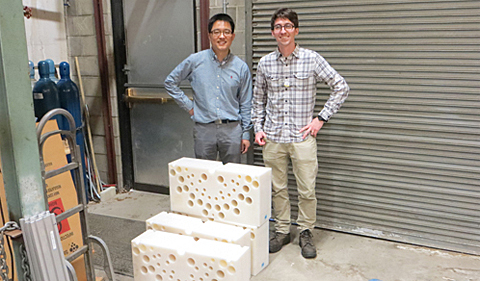
Nuclear Physicists Tony Ahn and Zach Meisel stand on the dock at the Edwards Accelerator Lab and behind section of the polyethylene blocks used to slow down neutrons. The holes are where the detectors are placed.
By Jean Andrews
Physics & Astronomy
Nuclear physicists from the University of Notre Dame, Michigan State University, University of Tennessee, and Central Michigan University visited Ohio University’s Edwards Accelerator Laboratory recently to calibrate a neutron detector called the Heavy ion Accelerated Beam induced (Alpha, Neutron) Emission Ratio Observer, or “HabaNERO.”
Lead physicist Dr. Zach Meisel, Postdoctoral Researcher at the University of Notre Dame, wanted to build a detector that measures reactions important to nuclear synthesis.
Nuclear synthesis involves the creation of elements above the element Iron that occur in a high-temperature environment that rapidly expand and cool. Under these conditions, charged-particle reactions play an important role in creating heavier mass nuclei.
“The experiment was part of a project that I initiated as a graduate student at Michigan State University,” Meisel says. “The project has since grown into a collaboration between the National Superconducting Cyclotron Laboratory at Michigan State University, the University of Notre Dame, Ohio University, Central Michigan University, the University of Tennessee, and Louisiana State University.”
Dr. David Ingram, Chair of Physics & Astronomy at OHIO, recently announced that Meisel has accepted a tenure-track assistant professor position this fall at Ohio University.
A Variation on NERO in Name and Function
HabaNERO was named in an inter-collaboration contest. Professor Hendrik Schatz of Michigan State University came up with the winning name, which is really just a backronym intended to tip their hats to the predecessor detector NERO, on which the HabaNERO idea is based.
Meisel came up with the idea of HabaNERO a few years ago with the help of Fernando Montes, a staff scientist at the NSCL at Michigan State. It is a variation on the idea of a neutron long-counter, which is itself an idea that has been around for about 60 years.
The purpose of the long-counter is to detect neutrons with high efficiency. This is critical for neutron-emitting reactions of astrophysical interest, since the reaction probabilities are often very low. This is especially the case for nuclear reactions involving radioactive nuclei, since they’re difficult to produce in the laboratory and so very few neutrons are produced.
In a long-counter, neutron-sensitive proportional counters are embedded in a large block of polyethylene or paraffin that surrounds a neutron-producing reaction. The neutrons are slowed by the block and ultimately captured by the proportional counters. This detector has a relatively large neutron detection efficiency (10s of percent), but all information about the original neutron energy is lost.
The issue with the traditional long-counter design is that, though it is efficient at detecting neutrons, it has a large drop in detection efficiency for increasing neutron energies. Therefore, if the original neutron energy spectrum is unknown, there is a large uncertainty in the efficiency of the detector.
“Past designs have tried to remedy this issue by increasing the detection efficiency for high-energy neutrons, but with little success, Meisel explains. “My idea was to purposely lower the detection efficiency of low-energy neutrons, which requires a relatively simple modification, thereby achieving a more constant detection efficiency up to neutron energies of ~20 MeV.”
An Inaugural Performance
Tony Ahn, a postdoctoral research associate at NSCL, has since refined the design and led the effort to bring HabaNERO to life.
HabaNERO will be used in the coming months to perform the first-ever nuclear reaction cross section measurements for alpha-capture, neutron-emission, also known as “(a,n)”, reactions on neutron-rich radioactive nuclei. In July, the collaboration will travel to the NSCL to perform the first of the (a,n) reaction measurements. These (a,n) reactions are thought to play a critical role in the production of the elements from Zinc to Tin in our universe.
HabaNERO will measure some of the most important (a,n) reactions at the energies these reactions are thought to occur in core collapse supernovae, explosions of massive stars at the end of their lifetimes, according to Meisel. In the experiment at Edwards Accelerator Lab, they validated the performance of the HabaNERO detector using the unique quasi-monoenergetic neutron beams that the laboratory can provide.
Specialized Equipment at Edwards Accelerator Laboratory
“The lab is one of the few facilities in the world with specially designed equipment allowing researchers to conduct experiments to better understand sub-atomic phenomena such as predicting the charged-particle reaction rates,” said Dr. Thomas Massey, Associate Research Professor at OHIO, explaining why the physicists traveled to Ohio University to conduct research.
The visiting physicists and their affiliated institutions include: Tony Ahn, Fernando Montes, Wei Jia Ong, Hendrik Schatz, Jorge Pereira, Konrad Schmidt, Justin Brown, and Eric Deleeuw (all from the National Superconducting Cyclotron Laboratory at Michigan State University), Manoel Couder and Zachary Meisel (from University of Notre Dame), Georgios Perdikakis and Panagiotis Gastis (from Central Michigan University), and Karl Smith (from the University of Tennessee, Knoxville).
Along with Massey, they met with faculty, staff, and graduate students from Ohio University including: Steven Grimes, Alexander Voinov, Carl Brune, Don Carter, and doctoral students Andrea Richard, Rekam Giri, Shamim Akhtar, Som Nath Paneru, and Sushil Dhakal.
Snapshots from the Visit
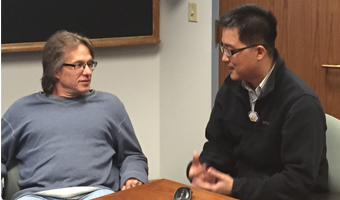
From left, Dr. Carl Brune discusses the experimental plan with Dr. Tony Ahn.
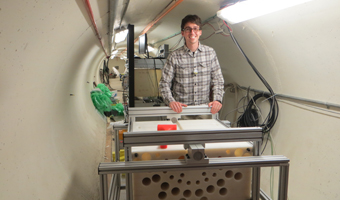
Dr. Zach Meisel works at taking the detector apart. He stands behind the polyethylene blocks that hold the detectors and slow down the neutron in the Time-of-Flight tunnel in the Accelerator.
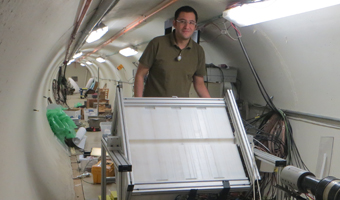
Dr. Fernando Montes rotates the detector to check the performance at a different angle.
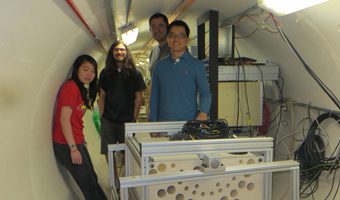
From left, Wei Jia Ong, Eric Deleeuw, Fernando Montes, and Tony Ahn
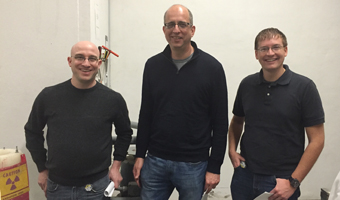
From left, Drs. Manoel Couder, Hendrik Schatz, and Karl Smith prepare to enter the Time-of-Flight Tunnel.
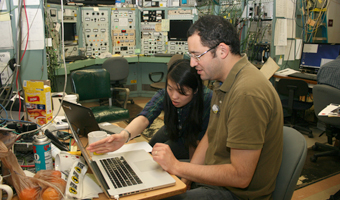
Ong and Montes review the data.
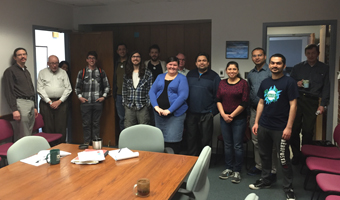
Faculty, staff and students taking part in the proceedings include (from left): OHIO Research Assistant Professor Paul King, and Distinguished Professor of Physics Steven Grimes, Visiting Graduate Assistant Wei Jia Ong, Visiting Physicists Zach Meisel, Fernando Montes, Eric Delleuw, OHIO Doctoral student Andrea Richard, Nuclear Instrumentation Engineer Don Carter, Doctoral Students Rekam Giri, Shamim Akhtar, Som Nath Paneru, Sushil Dhakal, and Research Assistant Professor Alexander Voinov.



















Comments